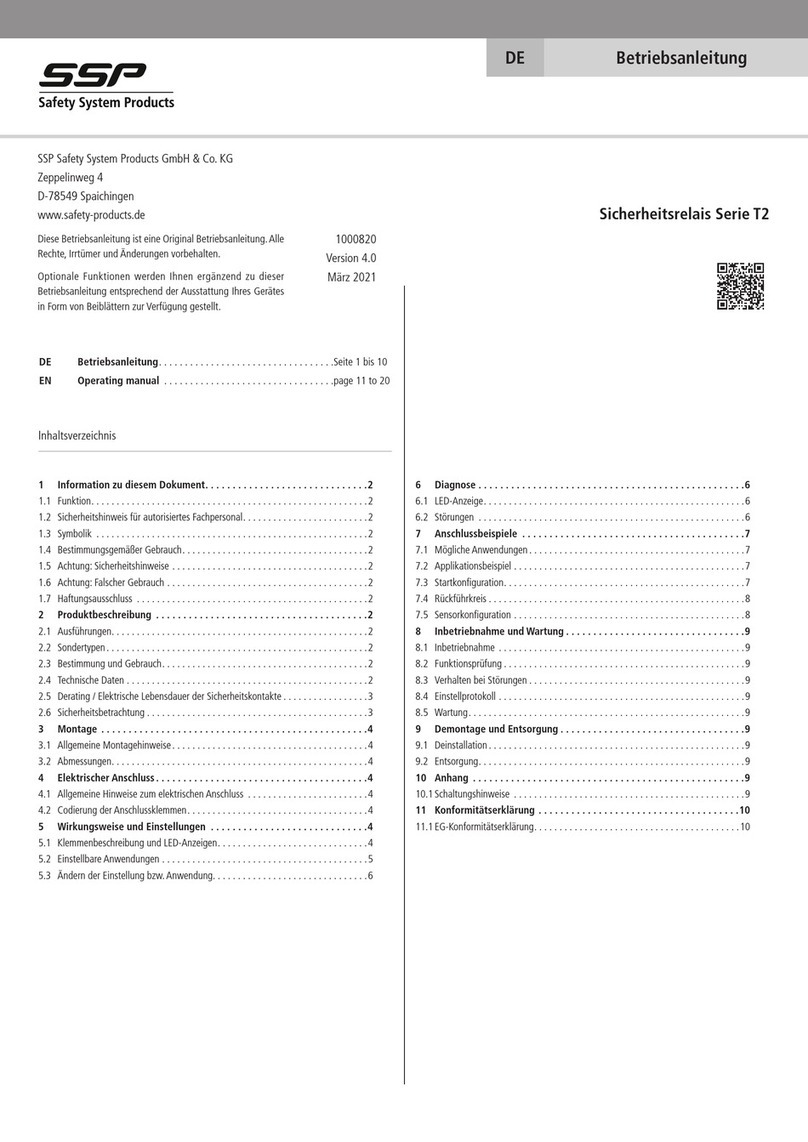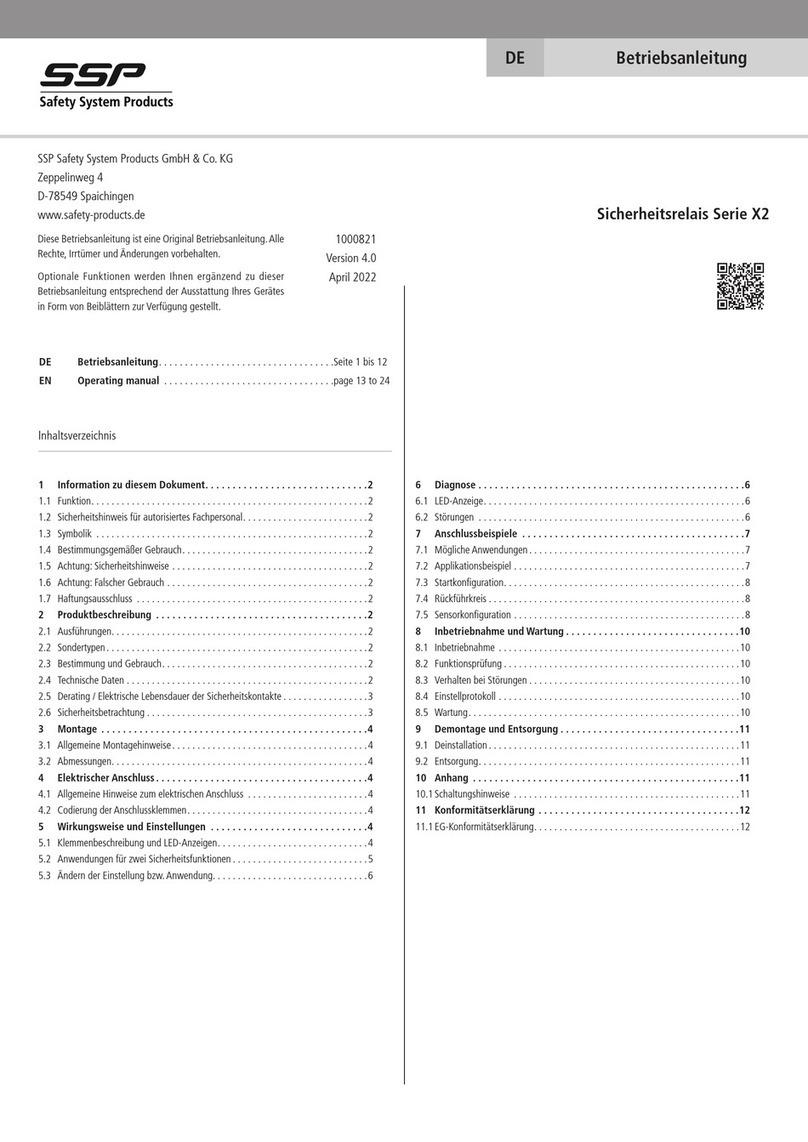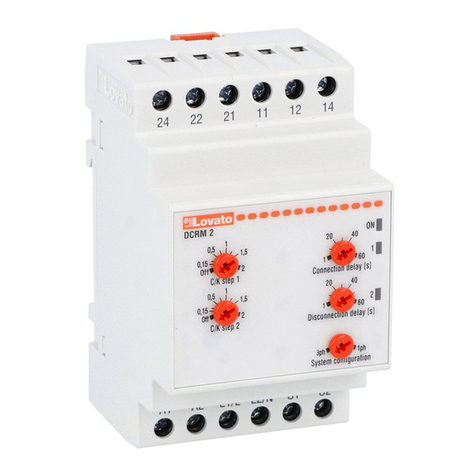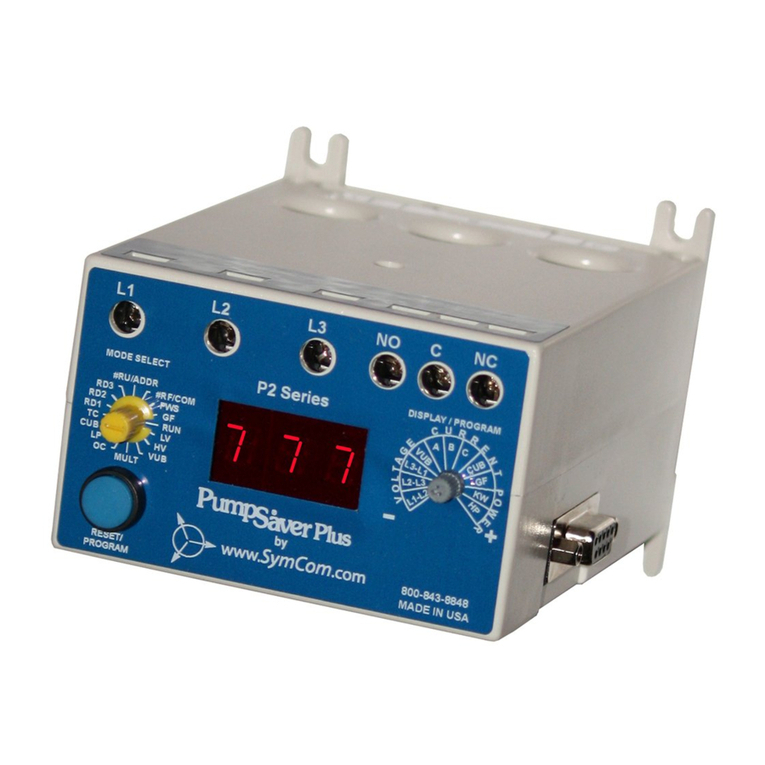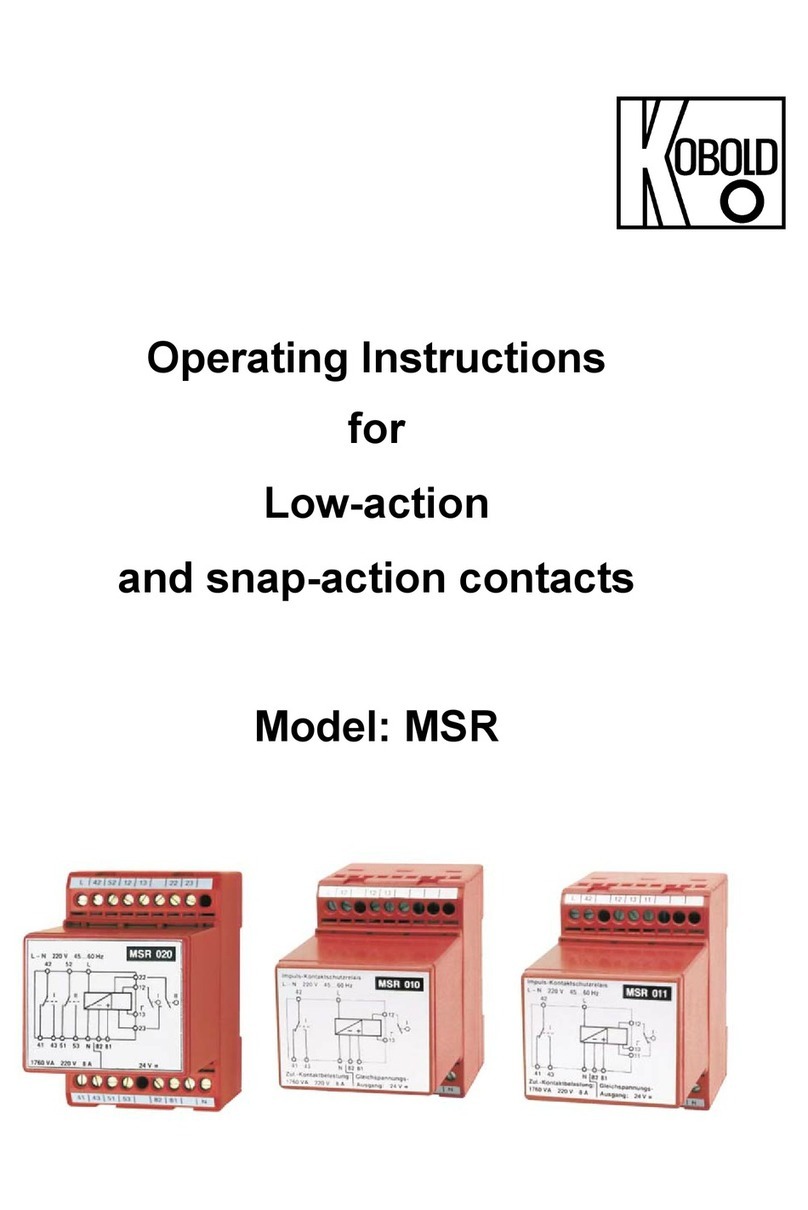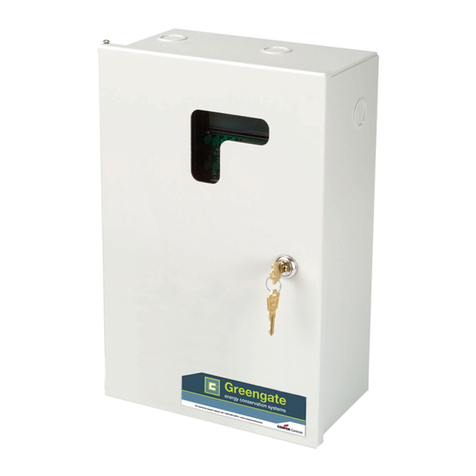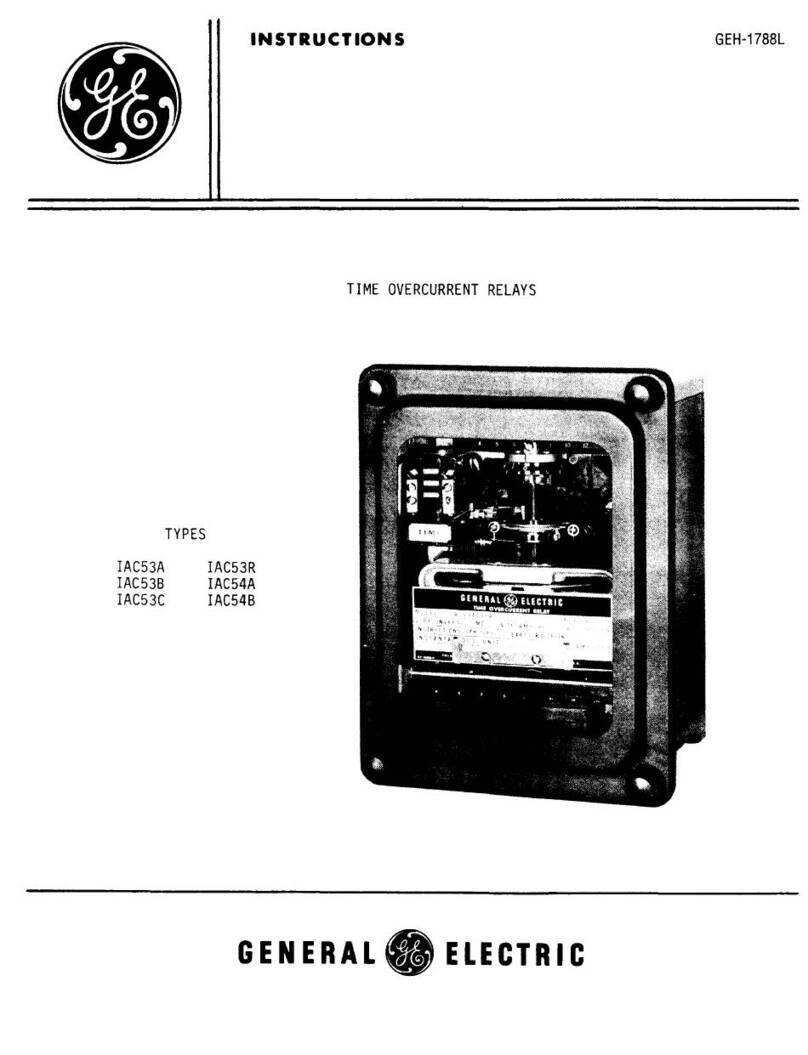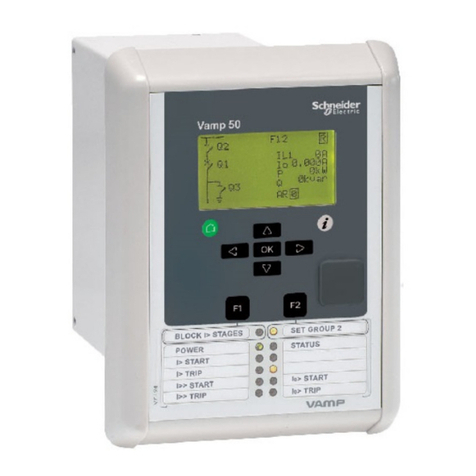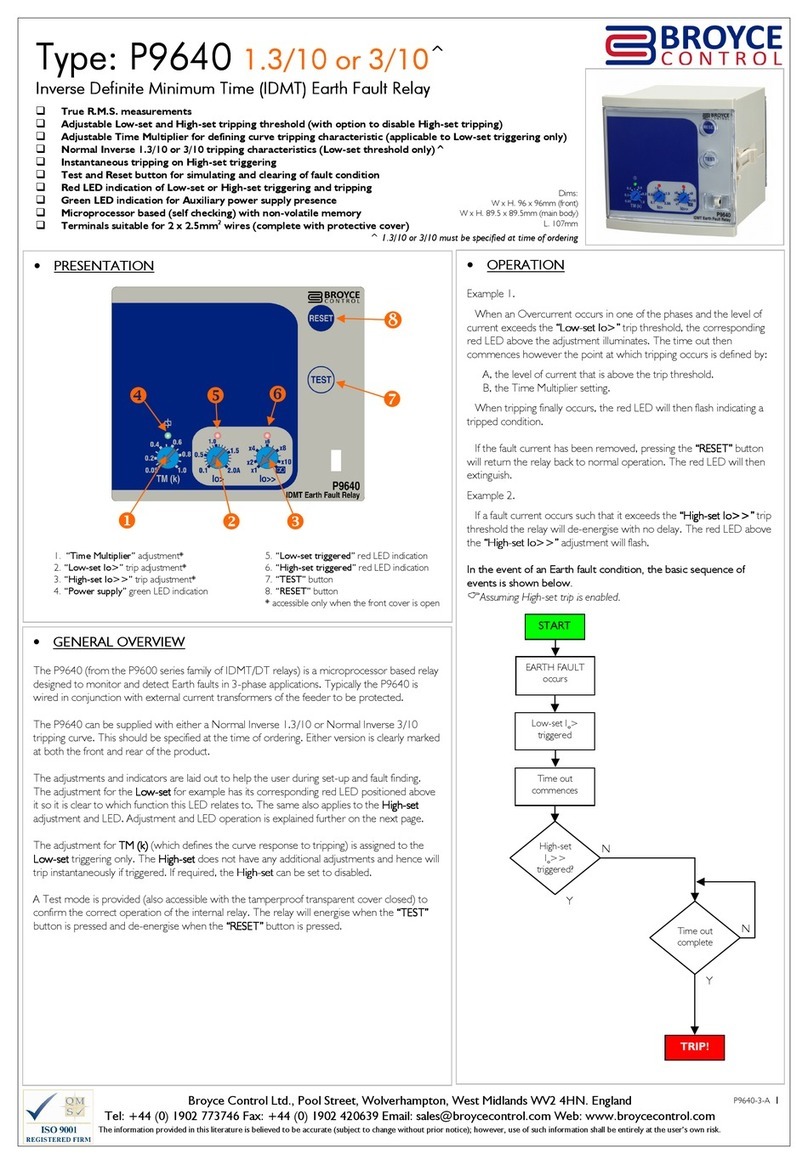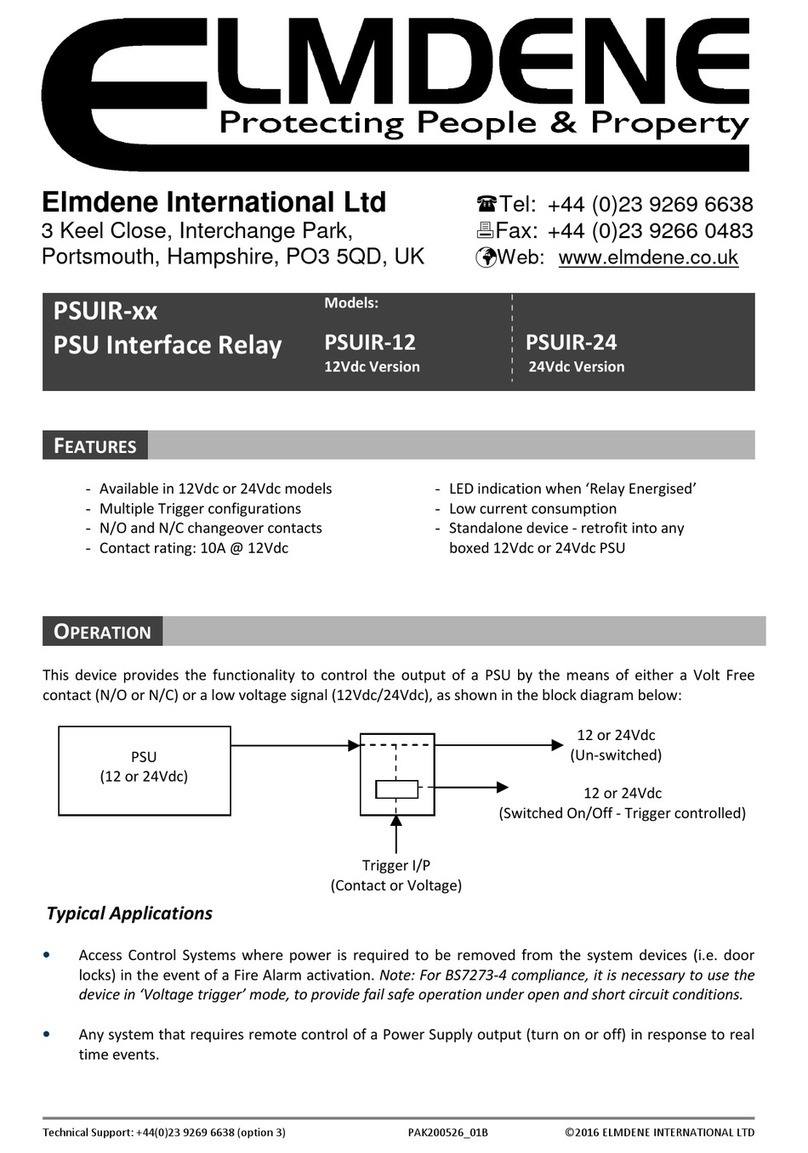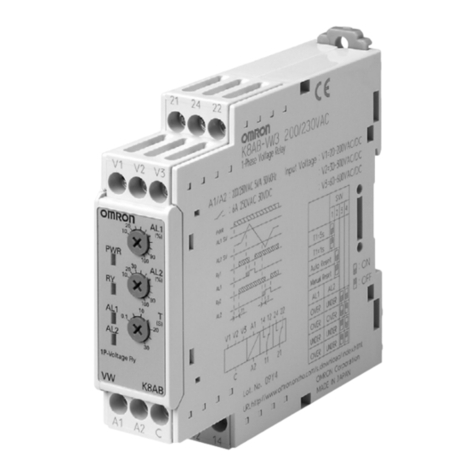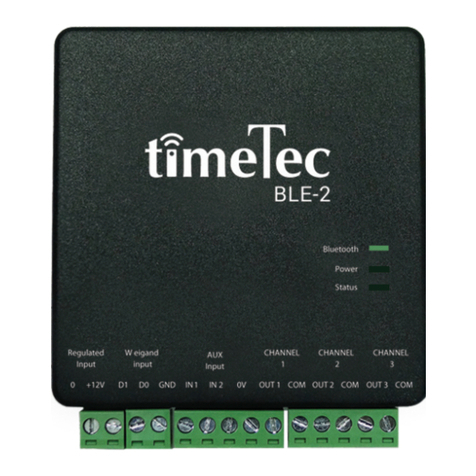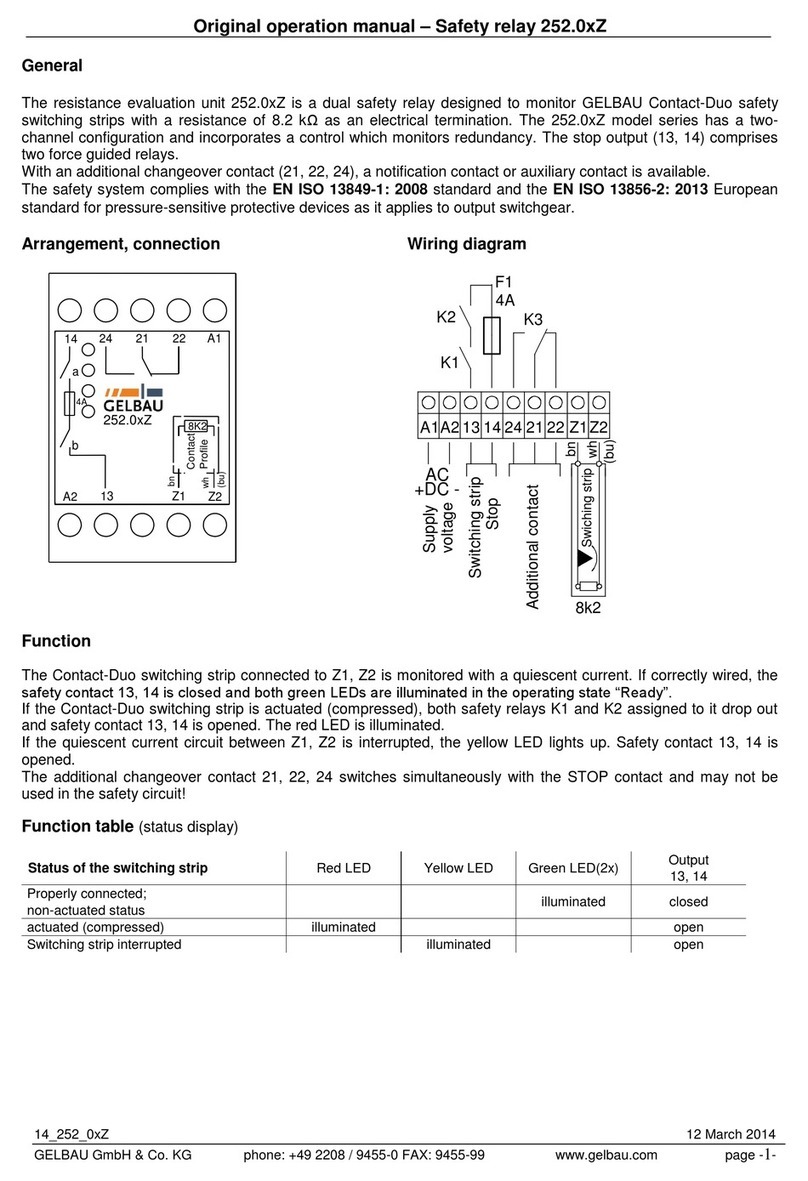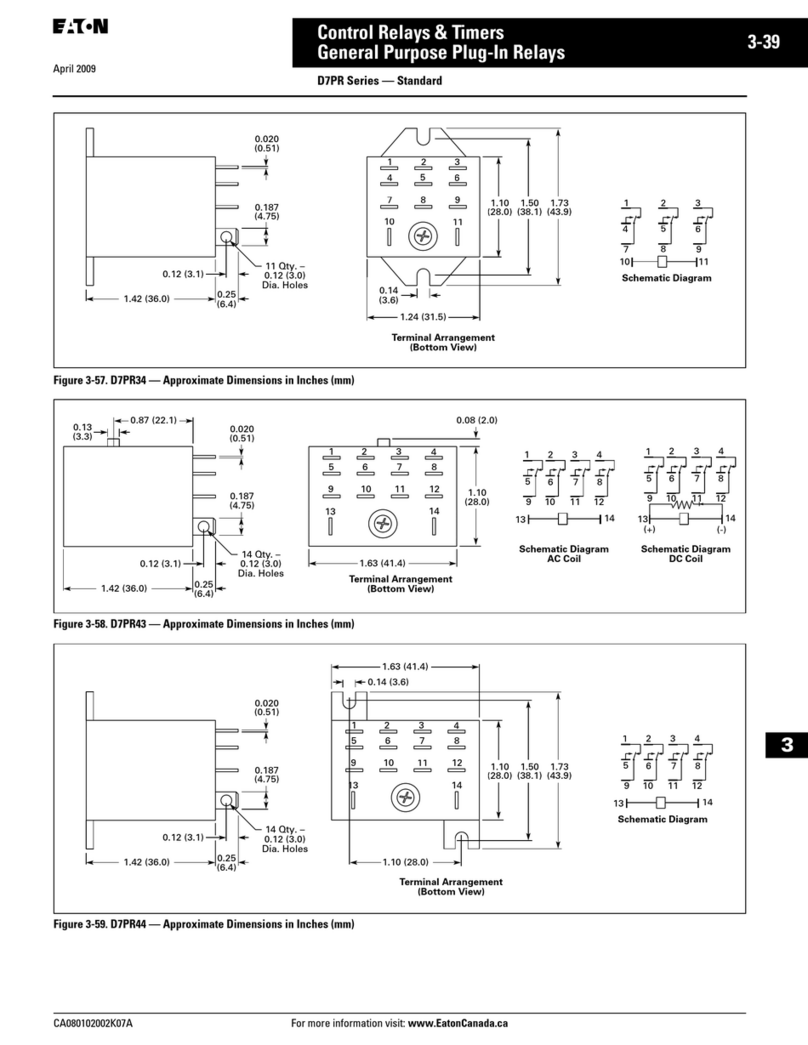SSP S2 Series User manual

Inhaltsverzeichnis
1000819
Version 2.0
August 2020
Sicherheitsrelais Serie S2
DE Betriebsanleitung
SSP Safety System Products GmbH & Co. KG
Zeppelinweg 4
D-78549 Spaichingen
www.safety-products.de
6 Diagnose .................................................6
6.1 LED-Anzeige....................................................6
6.2 Störungen .....................................................6
7 Anschlussbeispiele .........................................6
7.1 Mögliche Anwendungen ...........................................6
7.2 Applikationsbeispiel ..............................................6
7.3 Startkonfiguration................................................7
7.4 Rückführkreis ...................................................7
7.5 Sensorkonfiguration ..............................................7
8 Inbetriebnahme und Wartung .................................8
8.1 Inbetriebnahme .................................................8
8.2 Funktionsprüfung ................................................8
8.3 Verhalten bei Störungen ...........................................8
8.4 Einstellprotokoll .................................................9
8.5 Wartung.......................................................9
9 Demontage und Entsorgung ..................................9
9.1 Deinstallation ...................................................9
9.2 Entsorgung.....................................................9
10 Anhang ..................................................9
10.1 Schaltungshinweise ..............................................9
11 Konformitätserklärung .....................................10
11.1 EG-Konformitätserklärung.........................................10
1 Information zu diesem Dokument..............................2
1.1 Funktion.......................................................2
1.2 Sicherheitshinweis für autorisiertes Fachpersonal.........................2
1.3 Symbolik ......................................................2
1.4 Bestimmungsgemäßer Gebrauch.....................................2
1.5 Achtung: Sicherheitshinweise .......................................2
1.6 Achtung: Falscher Gebrauch ........................................2
1.7 Haftungsausschluss ..............................................2
2 Produktbeschreibung .......................................2
2.1 Ausführungen...................................................2
2.2 Sondertypen....................................................2
2.3 Bestimmung und Gebrauch.........................................2
2.4 Technische Daten ................................................2
2.5 Derating / Elektrische Lebensdauer der Sicherheitskontakte .................3
2.6 Sicherheitsbetrachtung . . . . . . . . . . . . . . . . . . . . . . . . . . . . . . . . . . . . . . . . . . . .3
3 Montage .................................................4
3.1 Allgemeine Montagehinweise.......................................4
3.2 Abmessungen...................................................4
4 Elektrischer Anschluss.......................................4
4.1 Allgemeine Hinweise zum elektrischen Anschluss ........................4
4.2 Codierung der Anschlussklemmen....................................4
5 Wirkungsweise und Einstellungen .............................4
5.1 Klemmenbeschreibung und LED-Anzeigen..............................4
5.2 Einstellbare Anwendungen .........................................5
5.3 Ändern der Einstellung bzw.Anwendung...............................5
Diese Betriebsanleitung ist eine Original Betriebsanleitung.Alle
Rechte, Irrtümer und Änderungen vorbehalten.
Optionale Funktionen werden Ihnen ergänzend zu dieser
Betriebsanleitung entsprechend der Ausstattung Ihres Gerätes
in Form von Beiblättern zur Verfügung gestellt.

2 DE
Sicherheitsrelais Serie S2
1. Information zu diesem Dokument
1.1 Funktion
Die vorliegende Betriebsanleitung liefert die erforderlichen Informationen für die Montage,
die Installation, den sicheren Betrieb sowie die Deinstallation der Sicherheitsbausteine. Die
Betriebsanleitung ist für die Lebensdauer des Geräts stets in einem leserlichen Zustand und
zugänglich aufzubewahren und vor Gebrauch sorgfältig zu lesen. Die Betriebsanleitung ist
an jeden nachfolgenden Besitzer und Benutzer des Gerätes weiterzugeben. Sie ist bei jeder
vom Hersteller erhaltenen Ergänzung zu aktualisieren.
1.2 Sicherheitshinweis für autorisiertes Fachpersonal
Die in dieser Betriebsanleitung beschriebenen Handhabungen sind nur durch ausgebildetes
und vomAnlagenbetreiber autorisiertes Fachpersonal auszuführen.Lesen und verstehen Sie
die Betriebsanleitung bevor Sie die Sicherheitsrelais Serie S2 in Betrieb nehmen.Machen
Sie sich mit den geltendenVorschriften über Arbeitssicherheit und Unfallverhütung vertraut.
Für den Einbau und die Installation sowie regelmäßige technische Überprüfungen gelten
die (inter-)nationalen Rechtsvorschriften.
1.3 Symbolik
Vorsicht
Bei Nichtbeachten der Warnhinweise können Störungen oder Fehlfunktionen
die Folge sein, des Weiteren können Personen und/oder Maschinen zu Schaden
kommen.
Information
Hilfreiche Zusatzinformationen
1.4 Bestimmungsgemäßer Gebrauch
Die hier beschriebenen Produkte wurden entwickelt, um als Teil einer Gesamtanlage oder
Maschine sicherheitsgerichtete Funktionen zu übernehmen.Es liegt imVerantwortungsbereich
des Herstellers einer Anlage oder Maschine, die korrekte Gesamtfunktion sicherzustellen.
Der Sicherheitsrelaisbaustein darf ausschließlich entsprechend der folgendenAusführungen
oder für durch den Hersteller zugelassene Anwendungen eingesetzt werden. Detaillierte
Angaben zum Einsatzbereich finden Sie im Kapitel „Produktbeschreibung“.
1.5 Achtung: Sicherheitshinweise
Die Sicherheitshinweise der Betriebsanleitung,gekennzeichnet durch oben stehendes Symbol
für Vorsicht bzw. Warnung, sowie landesspezifische Installations-, Sicherheits- und Unfall-
verhütungsvorschriften sind zu beachten.Weitere technische Informationen entnehmen Sie
bitte den SSP Datenblättern im Internet unter www.safety-products.de.
Alle Angaben ohne Gewähr. Änderungen, die dem technischen Fortschritt dienen, sind vor-
behalten.Restrisiken sind bei Beachtung der Hinweise zur Sicherheit sowie derAnweisungen
bezüglich Montage, Installation, Betrieb und Wartung nicht bekannt.
Das Gesamtkonzept der Steuerung, in welche die Sicherheitskomponente
eingebunden wird, ist nach EN ISO 13849-2 zu validieren.
1.6 Achtung: Falscher Gebrauch
Bei nicht sachgerechter oder nicht bestimmungsgemäßerVerwendung oder Manipulationen
können durch den Einsatz des Sicherheitsrelaisbausteines Gefahren für Personen oder Schäden
an Maschinen- bzw. Anlagenteilen nicht ausgeschlossen werden. Bitte beachten Sie auch
die diesbezüglichen Hinweise der Norm ISO 14119 und EN ISO 13850.
1.7 Haftungsausschluss
Für Schäden und Betriebsstörungen, die durch Montagefehler oder Nichtbeachtung dieser
Betriebsanleitung entstehen, wird keine Haftung übernommen. Für Schäden, die aus der
Verwendung von nicht durch den Hersteller freigegebenen Ersatz- oder Zubehörteilen re-
sultieren, ist jede weitere Haftung des Herstellers ausgeschlossen. Jegliche eigenmächtige
Reparaturen,Umbauten undVeränderungen sind aus Sicherheitsgründen nicht gestattet und
schließen eine Haftung des Herstellers für daraus resultierende Schäden aus.
2. Produktbeschreibung
2.1 Ausführungen
Diese Betriebsanleitung ist gültig für folgende Ausführungen:
Typenschlüssel Sicherheitsrelais Serie S2
2.2 Sondertypen
Für Sondertypen, die nicht im Typschlüssel unter Punkt 2.1 aufgeführt sind, gelten die vor-
und nachgenannten Angaben sinngemäß, soweit diese mit der serienmäßigen Ausführung
übereinstimmen.
2.3 Bestimmung und Gebrauch
Die Sicherheitsrelaisbausteine,zum Einsatz in Sicherheitsstromkreisen,sind für den Einbau in
Schaltschränken vorgesehen. Sie dienen der sicheren Auswertung der Signale von zwangs-
öffnenden Positionsschaltern oder Sicherheits-Sensoren für Sicherheitsfunktionen an seitlich
verschiebbaren,drehbaren und abnehmbaren Schutzeinrichtungen NOT-HALT-Befehlsgeräten,
Sicherheitsmagnetschaltern und AOPD’s.
Die Sicherheitsfunktion ist definiert als das Abschalten der Ausgänge Q1,Q2 und
13/14,23/24,33/34 beim Öffnen der Eingänge S12 und/oder S22. Die sicherheitsrele-
vanten Strompfade erfüllen unter Berücksichtigung einer PFH-Wert-Betrachtung folgende
Anforderungen (siehe auch Punkt 2.6 „Sicherheitsbetrachtung“)
• Kategorie 4 – PL e gemäß EN ISO 13849-1
• entspricht SIL 3 gemäß IEC 61508
• entspricht SILCL 3 gemäß EN 62061
Um den Performance Level (PL) gemäß EN ISO 13849-1 der gesamten Sicherheitsfunktion
(z.B. Sensor, Logik,Aktor) zu bestimmen, ist eine Betrachtung aller relevanten Komponenten
erforderlich.
2.4 Technische Daten
Allgemeine Daten
Vorschriften: IEC/EN 60204-1, EN 60947-5-1; EN ISO 13849-1,
IEC/EN 62061, IEC 61508
Störfestigkeit: gemäß EMV-Richtlinie
Luft- und Kriechstrecken: gemäß IEC/EN 60664-1
Befestigung: Normschiene nach EN 60715
Anschlussbezeichnung: EN 60947-1
Elektrische Kennwerte
Bemessungsbetriebsspannung Ue: 24 VDC / 24 VAC –20%/+20%
Frequenzbereich: 50 Hz/60 Hz
Netzteil/Netzversorgung: SELV-Netzteil gemäß DIN EN 60950;
Sicherheitstransformator gemäß DIN EN 61558-2-6 (AC); Die Netzversorgung muss
so auf die Geräteabsicherung (Charakteristik/Schmelzintegral) abgestimmt werden,
dass eine Auslösung gewährleistet ist.
Leistungsaufnahme: 2,4 W, 7 VA
Absicherung der Betriebsspannung: Wir empfehlen einen Sicherungsautomat
Typ Z (max. 16 A) oder eine Feinsicherung (max. 15 A, träge)
UL Rating of external fuse: max. 16 A, only use fuses in accordance with UL 248 series
Isolationskennwerte nach IEC 60664-1:
Bemessungsisolationsspannung Ui:
- Sicherheitskontakte: 250 V
- Sicherheitsausgänge: 50 V
Bemessungsstoßspannungsfestigkeit Uimp:
- Sicherheitskontakte 13-14, 23-24: 6 kV
- Sicherheitskontakt 33-34: 4 kV
- Sicherheitsausgänge: 0,8 kV
Überspannungskategorie: III
Verschmutzungsgrad: 2
Anzugsverzögerung: < 150 ms
Abfallverzögerung bei NOT-HALT: < 10 ms
Abfallverzögerung bei Netzausfall: < 10 ms
Überbrückung bei Spannungseinbrüchen: typ. 5 ms
Bereitschaft nach Spannung einschalten [s]: < 1,5 s

DE 3
Sicherheitsrelais Serie S2
Anschlussklemmen:
Steckbare Schraubklemmen:
Eindrähtig (starr) oder feindrätig (flexibel): 0,2 … 2,5 mm²
Feindrätig mit Aderendhülse: 0,25 … 2,5 mm²
Anzugsdrehmoment für Anschlussklemmen: 0,5 Nm
Steuerstromkreise/Eingänge
Eingänge S12, S22: 24 VDC/8 mA
Eingänge X2, X3, X7: 24 VDC/8 mA
Taktausgänge S11, S21: > 20 VDC, 10 mA je Ausgang
Leitungslängen: 1500 m mit 1,5 mm²;
2500 m mit 2,5 mm²
Leitungswiderstand: max. 40 Ω
Relais-Ausgänge
Schaltvermögen der Sicherheitskontakte: Kontakte 13-14, 23-24, 33-34:
max. 250 V, 6 A ohmsch,
min. 10 VDC / 10 mA
(Derating siehe 2.5)
Absicherung der Sicherheitskontakte: extern (Ik= 1000 A)
nach EN 60947-5-1
Schmelzsicherung 10 A flink, 6 A träge
Gebrauchskategorie nach EN 60947-5-1: AC-15: 230 V / 4 A
DC-13: 24 V / 4 A
Schaltvermögen der Hilfskontakte: 41-42: 24 VDC / 1 A
Absicherung des Hilfskontakte: Schmelzsicherung
2,5 A flink, 2 A träge
Elektrische Lebensdauer: siehe 2.5
Mechanische Lebensdauer: 10 Millionen Schaltspiele
Kennwerte Sicherheitskontakte: Widerstand max. 100 mΩ, AgNi,
selbstreinigend, zwangsgeführt
Max. Schaltzyklen/Minute: 20
Induktive Verbraucher: Es ist eine geeignete Schutzbeschaltung
zur Entstörung vorzusehen
Mechanische Daten
Werkstoff des Gehäuses: glasfaserverstärkter Thermoplast, belüftet
Gewicht: 175 g
Umgebungsbedingungen
Umgebungstemperatur: –25 °C … +60 °C (nicht betauend)
Lager- und Transporttemperatur: –40 °C … +85 °C (nicht betauend)
Schutzart: Gehäuse: IP40,
Klemmen: IP20,
Einbauraum: IP54
Schockfestigkeit: 30 g/11 ms
Schwingungsfestigkeit
nach EN 60068-2-6: 10 ... 55 Hz, Amplitude 0,35 mm
Höhenlage: max. 2.000 m
2.5 Derating / Elektrische Lebensdauer der Sicherheitskontakte
Kein Derating bei Einzelmontage der Bausteine.
Derating auf Anfrage bei Montage mehrerer Module nebeneinander ohne Abstand und
maximalen Ausgangsbelastungen und Umgebungstemperaturen.
Elektrische Lebensdauer der Sicherheitskontakte
DC13 24V
AC15 230V
AC1 230V
DC1 24V
10.000.000
1.000.000
100.000
10.000
0 1 2 3 4 5 6 7 8 9
Schaltspiele
Kontaktbelastung in Ampere
2.6 Sicherheitsbetrachtung
Sicherheitsbetrachtung Relaisausgang
Vorschriften: EN ISO 13849-1, IEC 61508, IEC/EN 62061
PL: e
Kategorie: 4
DC: hoch
CCF: > 65 Punkte
PFHD: ≤ 1,25 x 10-8 / h
PFDavg: ≤ 5,3 x 10-5
SIL: geeignet für Anwendungen in SIL 3
Gebrauchsdauer: 20 Jahre
Der PFH-Wert von 1,25 × 10-8/h gilt für die unten in derTabelle aufgeführten Kombinationen
von Kontaktlast (Strom über Freigabekontakte) und Schaltzyklenzahl (nop/y).Bei 365 Betriebs-
tagen pro Jahr und einem 24 Stunden Betrieb ergeben sich daraus die unten angegebenen
Schaltzykluszeiten (tcycle) für die Relaiskontakte.
Abweichende Anwendungen auf Anfrage.
Kontaktlast n
op/y
t
cycle
20 % 880.000 0,6 min
40 % 330.000 1,6 min
60 % 110.000 5,0 min
80 % 44.000 12,0 min
100 % 17.600 30,0 min

4 DE
Sicherheitsrelais Serie S2
3. Montage
3.1 Allgemeine Montagehinweise
Die Befestigung erfolgt via Schnellbefestigung für Normschienen gemäß EN 60715.Das Ge-
häuse mit der Oberseite in die Hutschiene einhängen und nach unten drücken bis es einrastet.
3.2 Abmessungen
Alle Maße in mm. Geräteabmessungen (H/B/T): 98 × 22,5 × 115 mm
4. Elektrischer Anschluss
4.1 Allgemeine Hinweise zum elektrischen Anschluss
Der elektrische Anschluss darf nur im spannungslosen Zustand und von auto-
risiertem Fachpersonal durchgeführt werden.
Bei Neuinstallation oder Austausch des Netzteils muss der Stecker der Aus-
gangsebene abgezogen und der korrekte Anschluss der Versorgung (A1)
kontrolliert werden.
Zur Vermeidung von EMV-Störgrößen müssen die physikalischen Umge-
bungs- und Betriebsbedingungen am Einbauort des Produktes dem Abschnitt
Elektromagnetische Verträglichkeit (EMV) der DIN EN 60204-1 entsprechen.
4.2 Codierung der Anschlussklemmen
1
0
time[s]
Sicherheitsrelais Serie T2
X7Qt1Y2Y1
2 42 31 41 3
1
Sicherheitsrelais Serie S2
5. Wirkungsweise und Einstellungen
5.1 Klemmenbeschreibung und LED-Anzeigen
Klemme Funktion LED Funktion
A1 Betriebsspannung
+ 24 VDC
24 VAC
RUN Betriebsspannung OK
RUN-Modus
Blinkcode siehe Abs. 6.1
A2 Betriebsspannung
0 V
24 VAC
ERR Fehlercode Siehe Abs. 6.2
X2 Eingang Startkreis
X3 Eingang Rückführkreis
S11/S21 Taktausgänge
S12 Eingang Kanal 1 In 1 High-Pegel an S12
Blinkcode siehe Abs. 6.1
S22 Eingang Kanal 2 In 2 High-Pegel an S22
Blinkcode siehe Abs. 6.1
41/42 Meldekontakt (NC)
13/14,
23/24,
33/34
Sicherheitskontakte Out Ausgänge aktiviert
Blinkcode siehe Abs. 6.1
1
Sicherheitsrelais Serie S2

DE 5
Sicherheitsrelais Serie S2
Einstellung der Anwendung mit dem Drehschalter „mode“
• Öffnen der transparenten Frontabdeckung (siehe Abb.).
• Das Öffnen erfolgt durch das Anheben an der Verschluss-Seite.
• Gewünschte Anwendung mit Drehschalter mode (1 … 10) durch Drehen nach oben
oder unten einstellen (siehe 5.3).
• Nach dem Einstellvorgang ist die Frontabdeckung wieder zu schließen.
• Die Frontabdeckung kann durch eine Plombe zum Schutz gegen ungewolltes Öffnen
gesichert werden
Bauelemente nur nach vorhergehender Entladung berühren!
5.2 Einstellbare Anwendungen
Drehschalter-
Position
Resettaster mit
Flankenüberwachung
Querschluss-
überwachung aktiv
Eingangs-/
Sensorkonfiguration
Überwachung der Sensorkanäle auf
Synchronität (< 5 s)
1Ja Ja NC / NC Ja
2Ja Ja NC / NC Nein
3Ja Nein NC / NC Ja
4Ja Nein NC / NC Nein
5Ja Ja NC / NO Ja
6 Autostart Ja NC / NO Nein
7 Autostart Ja NC / NC Ja
8 Autostart Ja NC / NC Nein
9 Autostart Nein NC / NC Ja
10 Autostart Nein NC / NC Nein
C Configuration mode
5.3 Ändern der Einstellung bzw. Anwendung
Beschreibung / Ablauf Drehschalter (mode) Systemverhalten LED Anzeigen
RUN In 1 In 2 Out
Werkseinstellung Position 1 Betriebsbereit für Anwendung 1 - - - -
Betriebsspannung anlegen Position 1 Ohne angeschlossene Sensorik ! Leuchtet - - -
Auf Position C drehen Anwendung 1 wird gelöscht Leuchtet Blinkt Blinkt Blinkt
Einstellzyklus aktiv Anwendung 1 ist gelöscht - - - -
Keine gültige Anwenung gespeichert Blinkt - - -
Sicherheitsrelais S2 bereit für neue Anwendungen
Neue Anwendung auswählen Gewünschte Anwendung einstellen (1-11) Neue Anwendung wird geladen Leuchtet - - -
Einstellzyklus aktiv
Leuchtet Leuchtet - -
Leuchtet Leuchtet Leuchtet -
Leuchtet Leuchtet Leuchtet Leuchtet
Betriebsbereit Gewünschte Anwendung ist eingestellt Neue Anwendung übernommen Leuchtet - - -
Betriebsspannung abschalten und Verdrahtung gemäß ausgewählter Anwendung vornehmen -> Sicherheitsrelais S2 betriebsbereit

6 DE
Sicherheitsrelais Serie S2
6. Diagnose
6.1 LED-Anzeige
LED Funktion Anzeigeart
RUN Betriebsbereit Leuchtet permanent
Keine gültige Anwendung Blinkt
In 1
Eingang S12 geschlossen Leuchtet permanent
Zeitfenster für Synchronität überschritten Blinkt schnell
Zweiter Kanal,
Eingang S22 hat nicht geöffnet
Blinkt langsam
In 2
Eingang S22 geschlossen Leuchtet permanent
Zeitfenster für Synchronität überschritten Blinkt schnell
Zweiter Kanal,
Eingang S12 hat nicht geöffnet
Blinkt langsam
Out
Sicherheitsausgänge EIN Leuchtet permanent
Sicherheitsausgänge warten auf Start (Eingang X2) Blinkt langsam
Rückführkreis nicht geschlossen
(Eingang X3)
Blinkt langsam
Einmaliges blinken aller LEDs bei Netz-Ein
6.2 Störungen
Störungen und Fehlerursachen werden mit der ERR-LED über kurze und lange Blinksignale
angezeigt
LED Fehlerursache Blinkt lang Blinkt kurz
ERR
Betriebsspannung zu niedrig 1 1
Betriebsspannung zu hoch 1 2
Drehschalterstellung ungültig 1 3
Querschluss zwischen den Eingängen S12 und S22 2 4
Undefinierte Pegel an Eingängen:
X2 3 4
X3 3 5
S12 2 9
S22 3 1
Drehschalter > 30 Sek. auf Position C 6 8
Anwendung geändert und
Zuschaltung der Betriebsspannung
LEDs blinken schnell: *1
RUN, In 1, In 2, Out
Anwendung wurde während dem
laufenden Betrieb geändert
LEDs blinken schnell:
ERR, In 1, In 2, Out
Andere Fehlercodes:
Rücksprache mit technischem Vertrieb der Firma SSP
*1) Fehlerbehebung
Bevor eine neue Funktion Programmiert werden kann, muss die alte Programmierung über
die Einstellung „C“ gelöscht werden.
7. Anschlussbeispiele
7.1 Mögliche Anwendungen
Alle Anwendungen für 1- oder 2-kanalige sichere Signal-Auswertung für folgende
Schutzeinrichtungen:
• Schutztürüberwachung nach ISO 14119
• Zwangsöffnende Positionsschalter nach IEC/EN 60947-5-1
• Sicherheits-Sensoren nach EN 60947-5-3
• NOT-HALT-Befehlsgeräte nach DIN EN ISO 13850 (EN 418) und EN 60947-5-5
• Sicherheits-Magnetschalter nach EN 60947-5-3
• Sicherheitslichtgitter und Sicherheitslichtschranken nach EN IEC 61496
7.2 Applikationsbeispiel
ZweikanaligeAnsteuerung, dargestellt am Beispiel eines Not-Halt-Tasters mit zweikanaliger
Signalüberwachung; mit externem Reset-Taster ®
• Leistungsebene: Zweikanalige Ansteuerung, geeignet zur Kontaktverstärkung bzw.
Kontaktvervielfältigung durch Schütze oder Relais mit zwangsgeführten Kontakten
• H2 = Rückführkreis
DerAnschluss von Sicherheitsmagnetschaltern an dieAuswerteschaltung SerieS2
ist nur bei Einhaltung der Anforderungen der Norm IEC 60947-5-3 zulässig.
Folgende Mindestanforderungen bezüglich der technischen Daten müssen
erfüllt werden:
• Schaltleistung: min. 240 mW
• Schaltspannung: min. 24 VDC
• Schaltstrom: min. 10 mA
Beispielhaft werden dieAnforderungen von folgenden SSP-Sicherheitssensoren
erfüllt:
• EDI C7
• EDI B7
• EDI I4
BeimAnschluss von Sensoren mit LED im Ansteuerkreis (Schutzkreis) ist darauf
zu achten, dass folgende Bemessungsbetriebsspannung eingehalten wird:
• 24 VDC mit einer max. Toleranz von –5%/+20%
Insbesondere bei Reihenschaltungen von Sensoren mit einem Spannungsabfall
im Ansteuerkreis, z.B. hervorgerufenen durch LED’s, kann es ansonsten zu
Verfügbarkeitsproblemen kommen.
Meldeausgänge dürfen in Sicherheitsstromkreisen nicht verwendet werden.

DE 7
Sicherheitsrelais Serie S2
Anschlussbeispiel 1
X3A1 S22S11
A2
S21X2S12
KA
0V / GND
KB
+24VDC
mode
Serie S2
KA
KB
KA
KB
F1
1
K1 K2
K2
K1
2313 33 41
2414 34 42
L1
N
R
H2
a)b)
c)d)
e)
Legende
a) Sicherheitseingänge b) Taktausgang
c) CPU d) Spannungsversorgung
e) Drehrad zur Programmierung
7.3 Startkonfiguration
Überwachter Start (Reset mit Flankenüberwachung)
• Der manuelle Start bzw. dieAktivierung des Bausteins erfolgt beim Loslassen desTasters.
X2
J
S11/S21
X2
+24 VDC
J
Überwachung der max. Betätigungszeit 0,03 s … 3 s.
Bei Zeitüberschreitung erfolgt kein Start des Bausteins!
Reset ohne Flankenüberwachung/Autostart
• Der manuelle Start bzw. dieAktivierung des Bausteins erfolgt bei Betätigung des Tasters
(nicht beim Loslassen!).
• Bei Autostart muss X2 zu S11, S21 oder +24 VDC gebrückt werden
X2
S11
X2
S21
X2
+24 VDC
Ohne zusätzliche Maßnahme nicht zulässig bei Hintertretgefahr!
Im Sinne von IEC/EN 60204-1 unterAbschnitt 9.2 ist die Betriebsart „Automa-
tischer Start” nur eingeschränkt zulässig. Insbesondere ist ein unabsichtlicher
Maschinen-Wiederanlauf durch andere geeignete Maßnahmen zu verhindern.
Reset-Taster mit
Flankenüberwachung
Reset-Taster ohne Flanken-
überwachung / Autostart
Drehschalter Position 1 Drehschalter Position 6
Drehschalter Position 2 Drehschalter Position 7
Drehschalter Position 3 Drehschalter Position 8
Drehschalter Position 4 Drehschalter Position 9
Drehschalter Position 5 Drehschalter Position 10
7.4 Rückführkreis
Geeignet zur Kontaktverstärkung bzw. Kontaktvervielfältigung durch Relais bzw. Schütze
mit zwangsgeführten Kontakten.
X3
S11/S21
X3
+24 VDC
KB
KA
KB
KA
Bei nicht benötigtem Rückführkreis ist dieser durch eine Brücke zu ersetzen.
X3
+24 VDC
7.5 Sensorkonfiguration
Einkanalige Signalverarbeitung
+24 VDC
S12 S22 S12 S22
S11 S21
Drehschalter
Position Funktion/Reset
4 Reset mit Flanken-Überwachung
10 Reset ohne Flanken-Überwachung / Autostart

8 DE
Sicherheitsrelais Serie S2
8. Inbetriebnahme und Wartung
8.1 Inbetriebnahme
Der Sicherheitsrelaisbaustein ist zur Montage in einem Schaltschrank mit der Schutzart
IP54 vorgesehen.
Der Sicherheitsrelaisbaustein ist bei Anlieferung betriebsbereit.
Werkseitig ist bereits die Anwendung 1 voreingestellt.
8.2 Funktionsprüfung
Der Sicherheitsrelaisbaustein ist hinsichtlich seiner Sicherheitsfunktion zu testen. Hierbei ist
vorab Folgendes zu gewährleisten:
1. Fester Sitz
2. Unversehrtheit der Leitungsverlegung und -anschlüsse
3. Gehäuse des Sicherheitsrelaisbausteins auf Beschädigungen überprüfen
4. Elektrische Funktion der angeschlossenen Sensorik und deren Wirkung auf den
Sicherheitsrelaisbaustein und nachgeschaltete Aktoren überprüfen
Der Sicherheitsrelaisbaustein verfügt über Selbsttestfunktionen.Ein erkannter Fehler führt zu
einem sicheren Zustand und ggf. zur unverzögerten Abschaltung aller Sicherheitsausgänge.
8.3 Verhalten bei Störungen
Im Falle einer Störung wird die folgende Vorgehensweise empfohlen:
1. Fehler anhand der Blinkcodes aus Kapitel 6.2 identifizieren.
2. Bei Fehlern, die in der Tabelle beschrieben sind, beheben Sie den Fehler.
3. Betriebsspannung aus- und einschalten um den Fehlermode zu löschen.
Wenn der Fehler nicht beseitigt werden konnte, wenden Sie sich bitte an den Hersteller.
Zweikanalige Signalverarbeitung NC / NC
Mit Querschluss-Überwachung (Kat. 4 - PL e gemäß DIN EN ISO 13849-1 erreichbar)
S12 S22
S11 S21
Drehschalter
Position
Querschluss-
Überwachung Synchronität Reset mit
Flankenüberwachung
1 ja ja ja
2 ja nein ja
7 ja ja Autostart
8 ja nein Autostart
Ohne Querschluss-Überwachung
(Kat. 4 - PL e gemäß DIN EN ISO 13849-1 nur erreichbar bei geschützter Kabelverlegung)
S12 S22
S11 S21
Drehschalter
Position
Querschluss-
Überwachung Synchronität Reset mit
Flankenüberwachung
3 nein ja ja
4 nein nein ja
9 nein ja Autostart
10 nein nein Autostart
Zweikanalige Signalverarbeitung NC / NO
(Kat. 4 - PL e gemäß DIN EN ISO 13849-1 erreichbar)
S12 S22
S11 S21
Drehschalter
Position Funktion/Reset
5 Reset mit Flanken-Überwachung
6 Reset ohne Flanken-Überwachung / Autostart
S12 S22
S11 S21
S12 S22
S11 S21 +24 VDC
S12 S22 S12
+24V
S22
+24V
+24 VDC
S12 S22 S12 S22
S11 S21

DE 9
Sicherheitsrelais Serie S2
8.4 Einstellprotokoll
Dieses Protokoll über die Einstellung des Geräts ist vom Kunden entsprechend zu ergänzen
und der technischen Dokumentation der Maschine beizufügen.
Das Einstellprotokoll muss bei einer Sicherheitskontrolle verfügbar sein.
Firma:
Der Baustein wird in folgender Maschine eingesetzt:
Maschinen-Nr. Maschinen-Typ Baustein-Nr.
Eingestellte Anwendung (mode):
Eingestellt am Unterschrift des Verantwortlichen
8.5 Wartung
In regelmäßigen Abständen empfehlen wir eine Sicht- und Funktionsprüfung mit folgenden
Schritten:
1. Sicherheitsrelaisbaustein auf festen Sitz prüfen
2. Zuleitung auf Beschädigung prüfen
3. Elektrische Funktion überprüfen
Wenn eine manuelle Funktionsprüfung zur Erkennung einer möglichen Feh-
leranhäufung notwendig ist, muss sie in den nachstehend angegebenen
Zeitabständen durchgeführt werden:
• mindestens monatlich für PL e mit Kategorie 3 oder Kategorie 4 (nach ISO
13849-1) oder SIL 3 mit HFT (Hardwarefehlertoleranz) = 1 (nach IEC 62061);
• mindestens alle 12 Monate für PL d mit Kategorie 3 (nach ISO 13849-1)
oder SIL 2 mit HFT (Hardwarefehlertoleranz) = 1 (nach IEC 62061).
Beschädigte oder defekte Geräte sind auszutauschen.
9. Demontage und Entsorgung
9.1 Deinstallation
Der Sicherheitsrelaisbaustein ist nur in spannungslosem Zustand zu demontieren.
9.2 Entsorgung
Der Sicherheitsrelaisbaustein ist entsprechend der nationalen bzw. regionalen Vorschriften
und Gesetze fachgerecht zu entsorgen.
10. Anhang
10.1 Schaltungshinweise
Luft- und Kriechstrecken der Sicherheitskontakte:
1
Sicherheitsrelais Serie S2
Die Sicherheitskontakte 13-14 und 23-24 erfüllen gegen alle anderenAnschlussklemmen, ohne
zusätzliche Maßnahmen,dieAnforderungen für doppelte Isolierung gemäß IEC/EN60664-1
und sind bei Schaltspannungen > 50V zu verwenden. Die Sicherheitskontakte 33-34 erfüllen
die Anforderungen für Basisisolierung.

10 DE
Sicherheitsrelais Serie S2
EG Konformitätserklärung
SSP Safety System Products GmbH & Co. KG
Zeppelinweg 4
78549 Spaichingen
Deutschland
www.safety-products.de
Hiermit erklären wir,dass die nachfolgend aufgeführten Bauteile aufgrund der Konzipierung und Bauart denAnforderungen der unten angeführten
Europäischen Richtlinien entsprechen
Bezeichnung des Bauteils Sicherheitsrelais Serie S2
Beschreibung Relais-Sicherheitskombination für NOT-HALT-Schaltungen,
Schutztürüberwachungen, Sicherheitsmagnetschalter und AOPD’s
Die bezeichneten Produkte erfüllen dieAnforderungen der Richtlinien 2006/42/EG - Maschinenrichtlinie
2014/30/EU – EMV
2011/65/EU - RoHS
Angewandte Normen ISO 13851:2002,
ISO 13849-1:2015,
ISO 13849-2:2012,
IEC 61508 Teile 1-7:2010,
IEC 62061:2015
Benannte Stelle der Baumusterprüfung TÜV Rheinland
Industrie Service GmbH
Alboinstr. 56, 12103 Berlin
Kenn-Nr.: 0035
EG-Baumusterprüfbescheinigung
01/205/5783.00/20
Bevollmächtigter für die Zusammenstel-
lung der technischen Unterlagen
Wolfgang Engelhart
Zeppelinweg 4
78549 Spaichingen
Ort und Datum der Ausstellung Spaichingen, 01. Mai 2020
Rechtsverbindliche Unterschrift
Johann Aulila
Geschäftsführer
Wolfgang Engelhart
Stellvertretender Geschäftsführer
11. Konformitätserklärung
11.1 EG-Konformitätserklärung
Hinweis
Die unterzeichnete EG-Konformitätserklärung finden Sie auf der SSP-Webseite:
www.safety-products.de
SSP Safety System Products GmbH & Co. KG
Zeppelinweg 4
78549 Spaichingen
+49 7424 98 049-0
info@ssp.de.com
www.safety-products.de

Table of Contents
1000819
Version 2.0
August 2020
Safety relays series S2
EN Operating manual
SSP Safety System Products GmbH & Co. KG
Zeppelinweg 4
D-78549 Spaichingen
www.safety-products.de
6 Diagnostic ...............................................16
6.1 LED indications.................................................16
6.2 Faults ........................................................16
7 Wiring examples ..........................................16
7.1 Possible applications.............................................16
7.2 Application example.............................................16
7.3 Start configuration ..............................................17
7.4 Feedback circuit ................................................17
7.5 Sensor configuration.............................................17
8 Set-up and maintenance ....................................18
8.1 Commissioning.................................................18
8.2 Functional testing...............................................18
8.3 Behaviour in the case of faults .....................................18
8.4 Setting report ..................................................19
8.5 Maintenance ..................................................19
9 Disassembly and disposal ...................................19
9.1 Disassembly ...................................................19
9.2 Disposal ......................................................19
10 Appendix ................................................19
10.1 Wiring/circuit information .........................................19
11 Declaration of Conformity...................................20
11.1 EC Declaration of Conformity ......................................20
1 Information about this document.............................12
1.1 Function......................................................12
1.2 Safety instruction for the authorized skilled personnel . . . . . . . . . . . . . . . . . . . .12
1.3 Symbols ......................................................12
1.4 Scope of application .............................................12
1.5 Attention: Safety Instructions ......................................12
1.6 Attention: Warning about misuse ...................................12
1.7 Exclusion of liability .............................................12
2 Products Description .......................................12
2.1 Design Types...................................................12
2.2 Special design types .............................................12
2.3 Technical data .................................................12
2.4 Derating / electrical lifespan of safety contacts .........................13
2.5 Safety classification..............................................13
3 Mounting................................................14
3.1 General mounting instructions .....................................14
3.2 Dimensions....................................................14
4 Electrical connection.......................................14
4.1 General information for electrical connection...........................14
4.2 Coding of cennecting terminals.....................................14
5 Operating principle and settings..............................14
5.1 Description of the terminals and LED indications ........................14
5.2 Adjustable Applications...........................................15
5.3 Changing setting or application ....................................15
This operating manual is a translation of the original operating
manual. All rights, errors and changes reserved.
Depending on equipment of your device, description of optional
functions in the form of additional sheets will be provided as a
complement to this operating manual.
DE Betriebsanleitung..................................Seite 1 bis 10
EN Operating manual .................................page 11 to 21

12 EN
Safety relays series S2
1. Information about this document
1.1 Function
This operating manual provides all necessary information for the assembly, installation,safe
operation and disassembly of the safety-monitoring module. The operating manual must
always be readable and available during the operating life of the device. Read the operating
manual carefully before using the device.Always hand this operating manual over to future
owners and users of the device. Add any supplement received from the manufacturer to
the operating manual.
1.2 Safety instruction for the authorized skilled personnel
The tasks described in this operating manual may only be carried out by trained skilled
personnel authorized by the plant owner. You must read and understand the operating
manual before starting the safety relay series S2.Familiarize yourself with the applicable
rules and regulations relating to industrial safety and accident prevention. National and
international legislation apply to assembly, installation and regular technical inspections.
1.3 Symbols
Caution
If the warnings are not observed, faults or malfunctions as well as injury to
persons and/or damage of the machines can occur.
Information
Helpful additional information
1.4 Scope of application
The described products have been developed to be a part of an overall system or machine-safety
related applications in process and automation technology.The manufacturer of the plant or
machine is responsible for ensuring the correct overall function of the system.
The safety-monitoring module may only be used in accordance with the following versions or
for applications approved by the manufacturer. For detailed information on the application
see Section 2. Product Description.
1.5 Attention: Safety Instructions
Observe the safety instructions in the operating manual, which are identified by above
symbol for caution or warning. Follow national installation, safety and accident prevention
regulations. For additional technical information refer to SSP data sheets or visit our website
at www.safety-products.de.
All information is supplied without liability. We reserve the right to make technical mod-
ifications for reasons of improvement. No remaining risks are known, if the safety notes
and instructions regarding assembly, installation, operation and maintenance are followed.
The entire concept of the control system, in which the safety component is
integrated, must be validated to EN ISO 13849-2.
1.6 Attention: Warning about misuse
In case of inadequate or improper use or manipulations of the safety-monitoring module,
personal hazards or damage to machinery or plant components cannot be excluded. The
relevant requirements of the standards ISO 14119 and EN ISO 13850 must be observed.
1.7 Exclusion of liability
We accept no liability for damages or operational malfunctions resulting from improper
installation or failure to comply with this operating manual. No other liability is accepted
by the manufacturer for damages resulting from use of spare parts or accessories, which
have not been approved by the manufacturer.Any unauthorized repairs,reconstructions and
modifications are not permitted for safety reasons and rule out liability of the manufacturer
for resulting damages.
2. Products Description
2.1 Design Types
This operating manual is valid for the following design types:
Ordering code safety relay series S2
2.2 Special design types
For special design types. that are not listed under 2.1 type code, the above and following
information is accordingly applicable if they correspond to the standard design.
2.3 Destination and use
The safety-monitoring modules for integration in safety circuits are designed for fitting in
control cabinets. They are used for the safe evaluation of the signals of positive break po-
sition switches or safety sensors for safety functions on slidinghinged and removable safety
guards as well as emergency stop control devices, safety solenoid switches and AOPD‘s.
The safety function is defined as deactivating outputs Q1,Q2 and 13/14,23/24,33/34 when
inputs S12 and/or S22 are opened.Taking account of a PFH value assessment,the safety-relevant
current paths meet the following requirements (see also chapter 2.6“Safety classification”):
• Control category 4 - PL e to EN ISO 13849-1
• SIL 3 to IEC 61508
• SILCL 3 to DIN EN 62061
To determine the Performance Level (PL) to EN ISO 13849-1 of the entire safety function (e.g.
sensor, logic, actuator), an assessment of all relevant components is required.
2.4 Technical data
General data
Standards: IEC/EN 60204-1, EN 60947-5-1; EN ISO 13849-1,
IEC/EN 62061, IEC 61508
EMC rating : to EMC Directive
Air clearances and creepage distances: to IEC/EN 60664-1
Mounting: standard DIN rail to EN 60715
Terminal designations: EN 60947-1
Electrical characteristics
Rated operating voltage Ue: 24 VDC / 24 VAC –20%/+20%
Frequency range: 50 Hz/60 Hz
Mains unit/mains power supply: SELV-Netzteil network as per DIN EN 60950;
safety transformer as per DIN EN 61558-2-6 (AC); mains power supply must harmonise
with device safety (characteristic/melting property) so that triggering is assured.
Power consumption: 2.4 W, 7 VA
Fuse rating for the operating voltage: we recommend a circuit breaker
type Z (max. 16 A) or a fine fuse (max. 15 A, delayed action)
UL Rating of external fuse: max. 16 A, only use fuses in accordance with UL 248 series
Insulation values to IEC 60664-1:
Rated insulation voltage Ui:
- safety contacts: 250 V
- safety outputs: 50 V
Rated impulse withstand voltage Uimp:
- safety contacts13-14. 23-24: 6 kV
- safety contact 33-34: 4 kV
- safety outputs: 0.8 kV
Overvoltage category: III
Degree of pollution: 2
Pull-in delay: < 150 ms
Drop-out delay in case of “emergency stop”: < 10 ms
Drop-out delay on “supply failure”: < 10 ms
Bridging in case of voltage drops: typ. 5 ms
Readiness after switching on voltage [s]: < 1.5 s
Terminal blocks
Pluggable screw terminal:
Single-wire (rigid) or fine-wire (flexible): 0.2 … 2.5 mm²
Fine-wired with wire sleeve: 0.25 … 2.5 mm²

EN 13
Safety relays series S2
Tightening torque for connection terminals: 0.5 Nm
Control current circuits/inputs
Inputs S12, S22: 24 VDC/8 mA
Inputs X2, X3, X7: 24 VDC/8 mA
Clock outputs S11, S21: > 20 VDC, 10 mA per output
Cable length: 1500 m with 1.5 mm²;
2500 m with 2.5 mm²
Conduction resistance: max. 40 Ω
Relay outputs
Switching capacity of the safety contacts: contacts 13-14, 23-24, 33-34:
max. 250 V, 6 A ohms,
min. 10 VDC / 10 mA
(Derating see 2.5)
Fuse rating of the safety contacts: external (Ik= 1000 A)
acc. to EN 60947-5-1
Safety fuse 10 A quick blow, 6 A slow blow
Utilisation category to EN 60947-5-1: AC-15: 230 V / 4 A
DC-13: 24 V / 4 A
Switching capacity of the auxiliary contacts: 41-42: 24 VDC / 1 A
Fuse rating for the auxiliary contact: safety fuse
2.5 A quick blow, 2 A slow blow
Electrical life: see 2.5
Mechanical life: 10 million operations
Safety contact values: resistance max. 100 mΩ, AgNi,
self-cleaning, positive action
Max. switching cycles/minute: 20
inductive consumers: provision is to be made for suitable
protective wiring for suppression
Mechanical data
Material of the housings: glass-fibre reinforced thermoplastic, ventilated
Weight: 175 g
Ambient conditions
Ambient temperature: –25 °C … +60 °C (non condensing)
Storage and transport temperature:: –40 °C … +85 °C (non condensing)
Protection class: Enclosure: IP40,
Terminals: IP20,
Clearance: IP54
Resistance to shock: 30 g/11 ms
Resistance to vibrations
to EN 60068-2-6: 10 ... 55 Hz, Amplitude 0.35 mm
Altitude: max. 2.000 m
2.5 Derating / electrical lifespan of safety contacts
No derating with individual installation of modules.
Derating on request if several modules are installed one after the other without spacing and
with maximum output load and ambient temperatures.
Electrical life of the safety contacts
DC13 24V
AC15 230V
AC1 230V
DC1 24V
10.000.000
1.000.000
100.000
10.000
0 1 2 3 4 5 6 7 8 9
Operations
Contact load in amperes
2.6 Safety classification
Classification of relay output
Standards: EN ISO 13849-1, IEC 61508, IEC/EN 62061
PL: e
Control Category: 4
DC: hoch
CCF: > 65 Punkte
PFHD: ≤ 1.25 x 10-8 / h
PFDavg: ≤ 5.3 x 10-5
SIL: suitable for SIL 3 applications
Service life: 20 years
The PFH value of 1.25 × 10-8/h applies to the combinations of contact load (current through
enabling contacts) and number of switching cycles (nop/y) mentioned in the table below. At
365 operating days per year and a 24-hours operation, this results in the below-mentioned
switching cycle times (tcycle) for the relay contacts.
Diverging applications upon request.
Contact load n
op/y
t
cycle
20 % 880.000 0.6 min
40 % 330.000 1.6 min
60 % 110.000 5.0 min
80 % 44.000 12.0 min
100 % 17.600 30.0 min

14 EN
Safety relays series S2
3. Mounting
3.1 General mounting instructions
Mounting: snaps onto standard DIN rails to EN 60715. Hook bottom of enclosure in DIN
rail and push down until it engages in position.
3.2 Dimensions
All measurements in mm. Device dimensions (H/W/D): 98 x 22.5 x 115 mm
4. Electrical connection
4.1 General information for electrical connection
The electrical connection may only be carried out by authorised personnel in
a de-energised condition.
If mains unit is a new installation or a replacement,the connector of the output
level must be removed and correct connection of the power supply (A1) must
be checked.
To avoid EMC disturbances,the physical ambient and operational conditions at
the place where the product is installed, must meet the provisions laid down
in the paragraph „Electromagnetic Compatibility (EMC)“ of DIN EN 60204-1.
4.2 Coding of cennecting terminals
1
0
time[s]
Sicherheitsrelais Serie T2
X7Qt1Y2Y1
2 42 31 41 3
1
Sicherheitsrelais Serie S2
5. Operating principle and settings
5.1 Description of the terminals and LED indications
Pin Function LED Function
A1 Operating voltage
+ 24 VDC
24 VAC
RUN Operating voltage OK
RUN-Modus
Flash code see section 6.1
A2 Operating voltage
0 V
24 VAC
ERR Error code see section 6.2
X2 Input start circuit
X3 Input feedback circuit
S11/S21 Test pulse output
S12 Input channel 1 In 1 High level an S12
Flash code see section 6.1
S22 Input channel 2 In 2 High level an S22
Flash code see section 6.1
41/42 Signalling contact (NC)
13/14.
23/24.
33/34
Safety outputs Out Outputs activated
Flash code see section 6.1
1
Sicherheitsrelais Serie S2

EN 15
Safety relays series S2
Adjustment of application using rotary “mode” switch
• Open front transparent cover (see fig.).
• Opening is carried out by lifting side with lock.
• Select desired application using rotary mode switch (1 … 10) by turning up or down
(see 5.3).
• After performing setting, close front cover again.
• Front cover can be secured with a lead seal to protect it from being opened unintentionally
Only touch the components after electrical discharge!
5.2 Adjustable Applications
Rotary knob
positions
Reset button (detection
of the trailing edge)
Cross-wire
monitoring active
Input / Sensor
configuration
Monitoring of sensor channels
for synchronisation (< 5 sec.)
1Yes Yes NC / NC Yes
2Yes Yes NC / NC No
3Yes No NC / NC Yes
4Yes No NC / NC No
5Yes Yes NC / NO Yes
6 Autostart Yes NC / NO No
7 Autostart Yes NC / NC Yes
8 Autostart Yes NC / NC No
9 Autostart No NC / NC Yes
10 Autostart No NC / NC No
C Configuration mode
5.3 Changing setting or application
Description / procedure Rotary (mode) switch System response LED indications
RUN In 1 In 2 Out
Factory setting position 1 Ready for application 1 - - - -
Switch operating voltage on position 1 Without connected sensors! Lights up - - -
Turn to position C Application 1 is deleted Lights up Flashes Flashes Flashes
Setting cycle active Application 1 is deleted - - - -
No valid application stored Flashes - - -
Safety relay S2 ready for new applications
Select new application Select desired application (1-11) New application will be loaded Lights up - - -
Setting cycle active
Lights up Lights up - -
Lights up Lights up Lights up -
Lights up Lights up Lights up Lights up
Ready for operation The desired application is configured Adopt new application Lights up - - -
Switch off operating voltage and connect wires according to selected application -> safety relay series S2 ready for operation

16 EN
Safety relays series S2
6. Diagnostic
6.1 LED indications
LED Function Display type
RUN Ready for operation Continuously lit
Not a valid appication Flashes
In 1
Eingang S12 geschlossen Continuously lit
Time window for synchronicity exceeded Flashes quickly
Second channel,
input S22 has not opened
Flashes slowly
In 2
Input S22 closed Continuously lit
Time window for synchronicity exceeded Flashes quickly
Second channel,
input S12 has not opened
Flashes slowly
Out
Safety outputs ON Continuously lit
Safety outputs waiting for start (input X2)
Flashes slowly
Feedback circuit not closed (input X3) Flashes slowly
Single flashing of all LEDs with mains on
6.2 Faults
Malfunctions and fault causes are displayed with the ERR-LEDs via short and long flashing signals
LED Error cause Long flash Short flash
ERR
Operating voltage too low 1 1
Operating voltage too high 1 2
Invalid rotary switch setting 1 3
Cross-wire between inputs S12 and S22 2 4
Undefinded level on outputs:
X2 3 4
X3 3 5
S12 2 9
S22 3 1
Rotary switch > 30 sec. to position C 6 8
Application changed and
activation of operating voltage
LEDs flash quickly: *1
RUN. In 1. In 2. Out
Application was changed during active operation LEDs flash quickly:
ERR. In 1. In 2. Out
Other fault codes:
Consult technical sales dept. at SSP
*1) Troubleshooting
Before a new function can be programmed, the old programming has to be deleted via
the setting “C”.
7. Wiring examples
7.1 Possible applications
All applications for 1 or 2-channel safe evaluation for protective equipment as follows:
• Safety door monitoring to ISO 14119
• position switches with positive break to IEC/EN 60947-5-1
• Safety sensors to EN 60947-5-3
• Emergency stop command devices to DIN EN ISO 13850 (EN 418) and EN 60947-5-5
• Magnetic safety sensors to EN 60947-5-3
• Safety light curtain and photoelectric barriers according to EN IEC 61496
7.2 Application example
Dual-channel control, shown for a guard door monitor with two position switches where
one has a positive break contact; with external reset button ®
• Relay outputs: suitable for 2-channel control, for increase in capacity or number of
contacts by means of contactors or relays with positive-guided contacts
• H2 = Feedback circuit
The connection of magnetic safety switches to the seriesS2 safety-
monitoring module is only admitted when the requirements of the standard
IEC60947-5-3 are observed.
As the technical data are regarded, the following minimum requirements
must be met:
• Switching capacity: min. 240 mW
• Switching voltage: min. 24 VDC
• Switching current: min. 10 mA
For example, the following safety sensors meet the requirements:
• EDI C7
• EDI B7
• EDI I4
When sensors with LED are wired in the control circuit (protective circuit), the
following rated operating voltage must be observed and respected:
• 24 VDC with a max. tolerance of –5%/+20%
Otherwise availability problems could occur, especially in series-wired sensors,
where a voltage drop in the control circuit is triggered by LED‘s for instance.
Signalling outputs must not be used in safety circuits.

EN 17
Safety relays series S2
Wiring example 1
X3A1 S22S11
A2
S21X2S12
KA
0V / GND
KB
+24VDC
mode
Serie S2
KA
KB
KA
KB
F1
1
K1 K2
K2
K1
2313 33 41
2414 34 42
L1
N
R
H2
a)b)
c)d)
e)
Key
a) Safety inputs b) Clock output
c) CPU d) Power supply
e) Rotary knob for programming
7.3 Start configuration
Monitored start (Reset with edge monitoring)
• Manual start or activation of the module occurs when the button is released (detection
of the trailing edge).
X2
J
S11/S21
X2
+24 VDC
J
Monitoring of max. actuation time 0.03 sec. … 3 sec.
If the time is exceeded, the module cannot be started!
Reset without edge monitoring/autostart
• The manual start or the activation of the module occurs when the button is pressed
(not when it is released!).
• With autostart, X2 must be bridged to S11, S21 or +24 VDC.
X2
S11
X2
S21
X2
+24 VDC
Not admitted without additional measure due to the risk of gaining access
by stepping behind!
Within the meaning of IEC/EN 60204-1 paragraph 9.2.5.4.2 the operating mode
„automatic start“ is only restrictedly admissible. In particular, any inadvertent
restart of the machine must be prevented by other suitable measures.
Reset button with
edge monitoring
Reset button without edge
monitoring / autostart
Rotary knob position 1 Rotary knob position 6
Rotary knob position 2 Rotary knob position 7
Rotary knob position 3 Rotary knob position 8
Rotary knob position 4 Rotary knob position 9
Rotary knob position 5 Rotary knob position 10
7.4 Feedback circuit
Suitable for increase in capacity or number of contacts by means of contactors or relays
with positive-guided contacts.
X3
S11/S21
X3
+24 VDC
KB
KA
KB
KA
If the feedback circuit is not required, establish a bridge.
7.5 Sensor configuration
Single channel signal processing
+24 VDC
S12 S22 S12 S22
S11 S21
Rotary knob
position Function/Reset
4 Reset (detection of the trailing edge)
10 Reset without monitoring / autostart

18 EN
Safety relays series S2
8. Set-up and maintenance
8.1 Commissioning
The safety relay module features protection class IP54 for installation in a switch cabinet.
The safety relay module is delivered ready for operation.
Application 1 is preset in the factory.
8.2 Functional testing
The safety function of the safety-monitoring module must be tested.The following conditions
must be previously checked and met:
1. Correct fixing
2. Check the integrity of the cable entry and connections
3. Check the safety-monitoring module’s enclosure for damage
4. Check the electrical function of the connected sensor technology and their influence
on the safety-monitoring module and the downstream actuators
The safety relay module features self-test functions. If a fault is detected,the system adopts
a safe mode and leads, if necessary, to undelayed deactivation of all safety outputs.
8.3 Behaviour in the case of faults
In the event of a fault the following procedure is recommended:
1. Identify faults according to flash codes from chapter 6.2.
2. Rectify the fault if it is described in the table.
3. Switch operating voltage off and on and erase fault mode.
If fault could not be rectified, please contact the manufacturer.
Dual channel signal processing NC / NC
With cross-wire monitoring (Cat. 4 - PL e to DIN EN ISO 13849-1 possible)
S12 S22
S11 S21
Rotary knob
position
Cross-wire
monitoring Synchronisation Reset witch
Edge monitoring
1 yes yes yes
2 yes no yes
7 yes yes autostart
8 yes no autostart
Without cross-wire monitoring
(Cat. 4 - PL e to DIN EN ISO 13849-1 only possible with protective wiring)
S12 S22
S11 S21
Rotary knob
position
Cross-wire
monitoring Synchronisation Reset witch
Edge monitoring
3 no yes yes
4 no no yes
9 no yes autostart
10 no no autostart
Dual channel signal processing NC / NO
(Cat. 4 - PL e to DIN EN ISO 13849-1 possible)
S12 S22
S11 S21
Rotary knob
position Function/Reset
5 Reset (detection of the trailing edge)
6 Reset without monitoring / autostart
S12 S22
S11 S21
S12 S22
S11 S21 +24 VDC
S12 S22 S12
+24V
S22
+24V
+24 VDC
S12 S22 S12 S22
S11 S21

EN 19
Safety relays series S2
8.4 Setting report
This report regarding the setting of the device must be completed accordingly by the customer
and enclosed in the technical documentation of the machine.
The setting report must be available whenever a safety check is performed.
Company:
The safety-monitoring module is used in the following machine:
Machine n° Machine type Module n°
Configured application (mode):
Set on (date) Signature of the responsible person
8.5 Maintenance
A regular visual inspection and functional test,including the following steps, is recommended:
1. Check the correct fixing of the safety-monitoring module
2. Check the cable for damages
3. Check electrical function
If a manual functional check is necessary to detect a possible accumulation of
faults, then this must take place during the intervals noted as follows:
• at least every month for PL e with category 3 or category 4 (according to
ISO 13849-1) or SIL 3 with HFT (hardware fault tolerance) = 1 (according
to IEC 62061);
• at least every 12 months for PL d with category 3 (according to ISO 13849-1)
or SIL 2 with HFT (hardware fault tolerance) = 1 (according to IEC 62061).
Damaged or defective components must be replaced.
9. Disassembly and disposal
9.1 Disassembly
The safety-monitoring module must be disassembled in a de-energised condition only.
9.2 Disposal
The safety-monitoring module must be disposed of in an appropriate manner in accordance
with the national prescriptions and legislations.
10. Appendix
10.1 Wiring/circuit information
Air clearances and creepage distances of the safety contacts:
1
Sicherheitsrelais Serie S2
Against all other connection terminals, the safety contacts 13-14 and 23-24 comply with-
out additional measures with the requirements for double insulation in accordance with
IEC/EN60664-1 and are to be used with switch voltages > 50V.The safety contacts 33-34
comply with the requirements for basic insulation.

20 EN
Safety relays series S2
EC Declaration of Conformity
SSP Safety System Products GmbH & Co. KG
Zeppelinweg 4
78549 Spaichingen
Germany
www.safety-products.de
We hereby declare that the following components comply with the requirements of the European Directives listed below with regard to their
design and construction.
Denomination of the component Safety relays series S2
Description Safety-monitoring module for emergency stop circuits, guard door moni-
toring, magnetic safety switches, two-hand control panels and AOPD‘s
The designated products comply with the requirements of the directives 2006/42/EG - Machinery Directive
2014/30/EU - EMC
2011/65/EU - RoHS
Applied standards ISO 13851:2002.
ISO 13849-1:2015.
ISO 13849-2:2012.
IEC 61508 parts. 1-7:2010.
IEC 62061:2015
Authorized representative for the compila-
tion the technical documentation
TÜV Rheinland
Industrie Service GmbH
Alboinstr. 56, 12103 Berlin
Kenn-Nr.: 0035
EC-prototype test certificate
01/205/5783.00/20
Person authorised for the compilation
of the technical documentation
Wolfgang Engelhart
Zeppelinweg 4
78549 Spaichingen
Place and date of issue Spaichingen, Germany, May 1, 2020
Legally binding signature
Johann Aulila
CEO
Wolfgang Engelhart
Deputy CEO
11. Declaration of Conformity
11.1 EC Declaration of Conformity
Note
Signed EC Declaration of Conformity is available at the SSP website:
www.safety-products.de
SSP Safety System Products GmbH & Co. KG
Zeppelinweg 4
78549 Spaichingen
+49 7424 98 049-0
info@ssp.de.com
www.safety-products.de
Table of contents
Languages:
Other SSP Relay manuals
